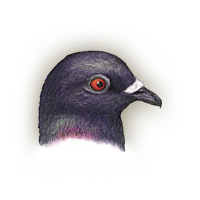 |
Rock Dove
Columba livia |
|
|
ART LINK | ||
|
STANFORD LOCATIONS: This exotic species is a fairly common breeder throughout main campus, nesting exclusively on buildings and other artificial structures. |
 |
Location |
Type |
Mating System |
Parental Care |
2ndary Diet |
Strategy |
|
|
|
|
I: 16-19 DAYS ALTRICIAL |
|
|
|
|
|
(1-2) MONOG |
MF |
| BREEDING: | Cities, towns, rural areas, but always near human habitations. 4-5 or more broods. |
| DISPLAYS: | Courting male inflates neck, spreads tail, and with much bowing accompanied by polysyllabic cooing, pursues female on ground, following and circling around her. |
| NEST: | On building ledge, under eaves, under bridges, etc.; rarely on cliff ledge, the presumed ancestral type of nest site. Loose saucer of roots, stems, leaves, etc., no lining. |
| EGGS: | White, unmarked. 1.6" (39 mm). |
| DIET: | Esp grain, occ green leaves, invertebrates. Young initially fed crop milk. |
| CONSERVATION: | Winter resident. Introduced. |
| NOTES: | Gregarious, often seen in flocks when roosting, feeding or flying; prefer to breed in groups. Impressive flight capability, marked by much gliding and wheeling; often glide to landing. May breed at 6 months. Young brooded for 7 days. Urban feeding groups are not closed flocks; individuals sample many feeding sites, temporarily adopting particularly good sites. Marked individual feeding preferences. |
| ESSAYS: | Bird Milk; Navigation and Orientation; Urban Birds; Feral Birds; Monogamy. |
| REFERENCES: | Cramp, 1985; Giraldeau and Lefebvre, 1985; Lefebvre, 1985. |
| Help | Abbreviations | Species-Alphabetical | Species-Taxonomic | Essays-Alphabetical | |
| Except for Stanford Locations, the material in this species treatment is taken, with permission, from The Birder's Handbook (Paul Ehrlich, David Dobkin, & Darryl Wheye, Simon & Schuster, NY. 1988). | |||||